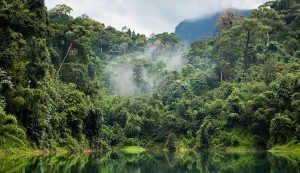Climate Change
How deforestation for animal agriculture threatens our forests
March 19, 2020

Image source: Dhruva Reddy/Unsplash
We couldn’t live without forests. Covering one third of the earth’s land mass, they’re vital to sustaining life on our planet and slowing down climate change. Forests are key to climate, water, health and livelihoods, yet we’re losing them at an alarming rate due to deforestation – the mass destruction of trees. One of the leading causes of deforestation globally is animal agriculture, which is why a plant-based diet can help.
Today, nearly 70% of cleared lands in the Amazon, the largest remaining tropical rainforest in the world, are used as cattle pastures. Vast swathes of forest, grasslands and wetlands are cleared to provide land for grazing and growing animal feed crops.
We can help protect forests by choosing more sustainable eating habits and switching to a plant-based diet. Here, we take a look at how forests are threatened by deforestation for animal agriculture, and the steps we can take.
3 key benefits of forests threatened by deforestation for animal agriculture:
1. Forest biodiversity helps ecosystems thrive
Forests cover around one-third of the Earth’s landmass and are the most biologically diverse ecosystems on land, home to over 80% of animals, plants, and insects. Each plant or animal species, no matter how small, has an important role to play, and maintaining biodiversity boosts ecosystem productivity. For example, a large number of plant species enables a greater range of crops, which helps to ensure food security.
Habitat loss due to deforestation poses a huge threat to biodiversity, which supports human life to the extent that it affects the air we breathe, the water we drink, and the food we eat. Continued deforestation in the Amazon will lead to the ecosystems we need to survive being no longer supported.
A plant-based diet is better for the planet
Reducing animal products has numerous positive effects, including preservation of biodiversity, more sustainable use of resources, and combatting climate change.
2. Forests regulate carbon in our atmosphere
Forests are critical to regulating the world’s climate and weather cycles. The Amazon rainforest is often referred to as ‘the lungs of the earth’ because its forests release oxygen and store carbon dioxide – a major cause of global warming. Forests are crucial to addressing the climate crisis as they absorb over 2 billion tons of carbon dioxide every year, which is one-third of the CO2 released from burning fossil fuels.
When deforestation for animal agriculture occurs, this carbon is re-emitted into the atmosphere, contributing significantly to global warming and preventing us from reaching the goals of the Paris Climate Agreement.
3. Forests preserve land quality and support indigenous populations
Pasture expansion to meet the demand for beef, as well as for the production of animal feed crops, such as soya and corn, are the main drivers of deforestation in the Amazon. This puts fertile topsoils, which are rich in organic matter, at risk of erosion.
These priceless natural resources can’t be restored within our lifetime. Agricultural machinery, over-fertilization, toxins and monocultures deplete and loosen the soil, which is then carried away by wind and rain. Poor soil leads to weak harvests, which in turn requires more farmland to compensate, leading to more deforestation.
Deforesting land for animal agriculture also threatens the rights of indigenous people, as the land often overlaps with indigenous territories. Over 2000 indigenous cultures are dependent on forests for their livelihoods, medicines, food and shelter. The protection of indigenous rights is recognized as one of the best ways to protect forests and thus lower carbon emissions.
Let us help you go plant-based
Take a look at our wealth of practical resources to see how easy and delicious switching to a plant-based lifestyle can be.
Can a plant-based diet help reduce deforestation?
Our daily diet choices can have an impact on the survival of the planet’s forests. A number of studies show that choosing a plant-based diet can help to decrease land requirements.[1]Hallström, E., A. Carlsson-Kanyama & P. Börjesson (2015): Environmental impact of dietary change: a systematic review. Journal of Cleaner Production. 91, p.1–11 [2]Peters, C.J., J. Picardy, J. L. Wilkins, T.S. Griffin, G.W. Fick & A.F. Darrouzet-Nardi(2016): Carrying capacity of US agricultural land: Ten diet scenarios. Elementa: Science of the Anthropocene … Continue reading [3]Meier, T., O. Christen, E. Semler, G. Jahreis, L. Voget-Kleschin, A. Schrode & M. Artmann (2014): Balancing virtual land imports by a shift in the diet. Using a land balance approach to assess … Continue reading While a 2017 study revealed that up to 55% of deforestation can be reduced by decreasing the consumption of animal products, as less land is needed for animal agriculture.
As well as eating a more plant-based diet, we can spread awareness of the climate impact of our food choices. The topic of deforestation is beginning to gain traction globally, and ProVeg continually advocates for an urgent switch to a plant-based diet and more sustainable food system. We also plan to highlight the link between diet and deforestation on the global stage in 2021, at the next UN Environment Assembly in Nairobi.
Switching to a plant-based diet has never been easier and has so many positive effects – including preservation of biodiversity, more sustainable use of resources, and combatting climate change. By switching to a more sustainable diet, we can help to preserve the ecological, economic, social and health benefits of forests.
References[+]
| ↑1 | Hallström, E., A. Carlsson-Kanyama & P. Börjesson (2015): Environmental impact of dietary change: a systematic review. Journal of Cleaner Production. 91, p.1–11 |
|---|---|
| ↑2 | Peters, C.J., J. Picardy, J. L. Wilkins, T.S. Griffin, G.W. Fick & A.F. Darrouzet-Nardi(2016): Carrying capacity of US agricultural land: Ten diet scenarios. Elementa: Science of the Anthropocene 4, no. 1 (2016): 1. |
| ↑3 | Meier, T., O. Christen, E. Semler, G. Jahreis, L. Voget-Kleschin, A. Schrode & M. Artmann (2014): Balancing virtual land imports by a shift in the diet. Using a land balance approach to assess the sustainability of food consumption. Germany as an example. Appetite. p.20–34 |



